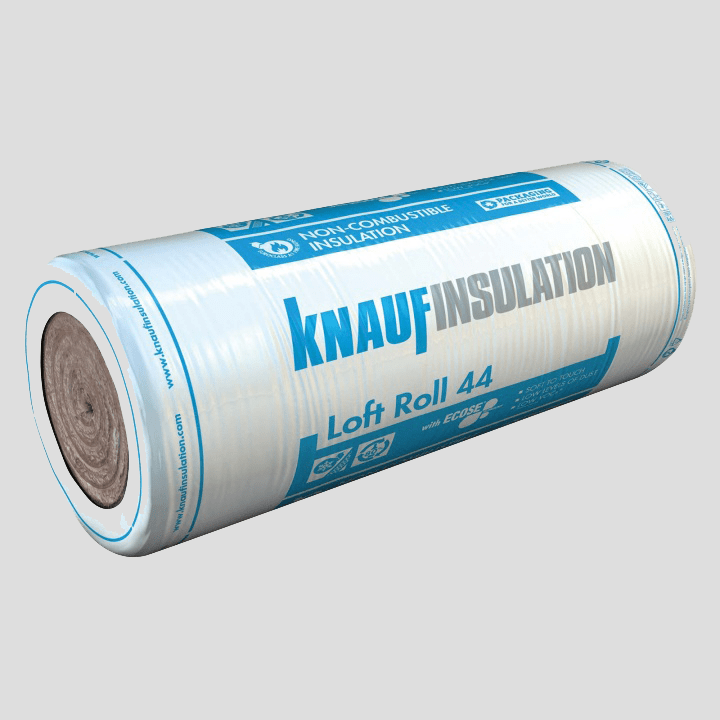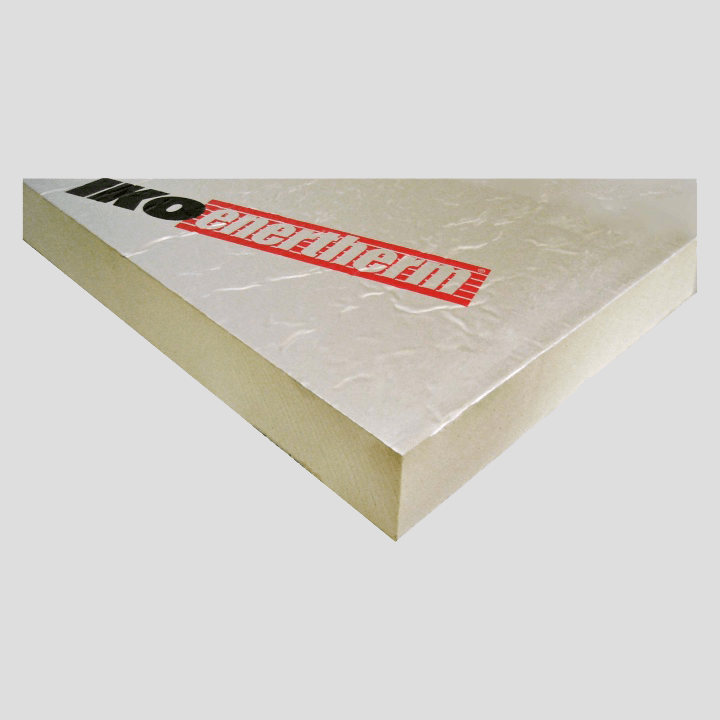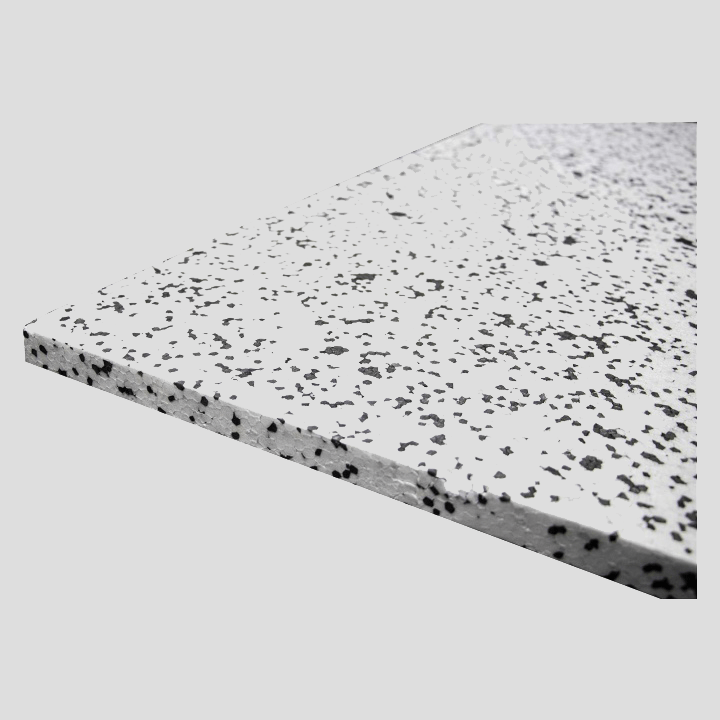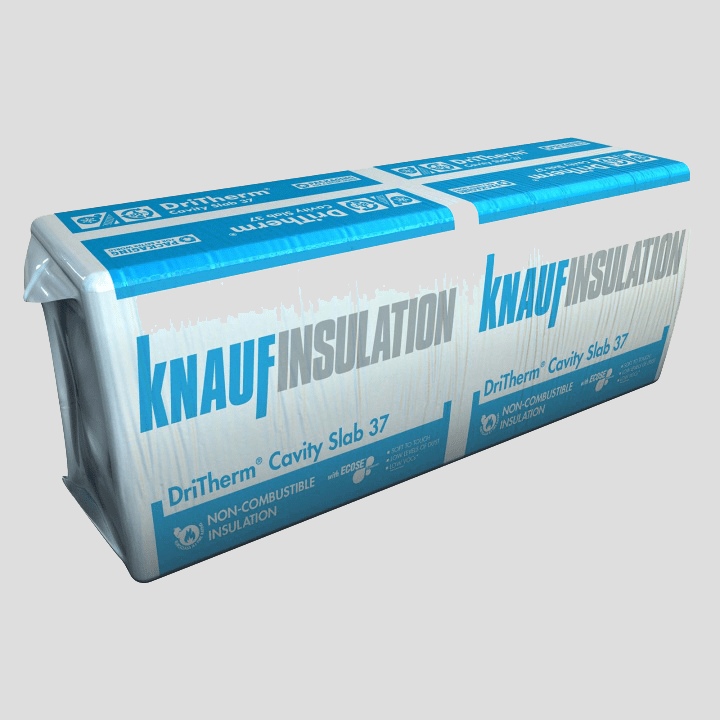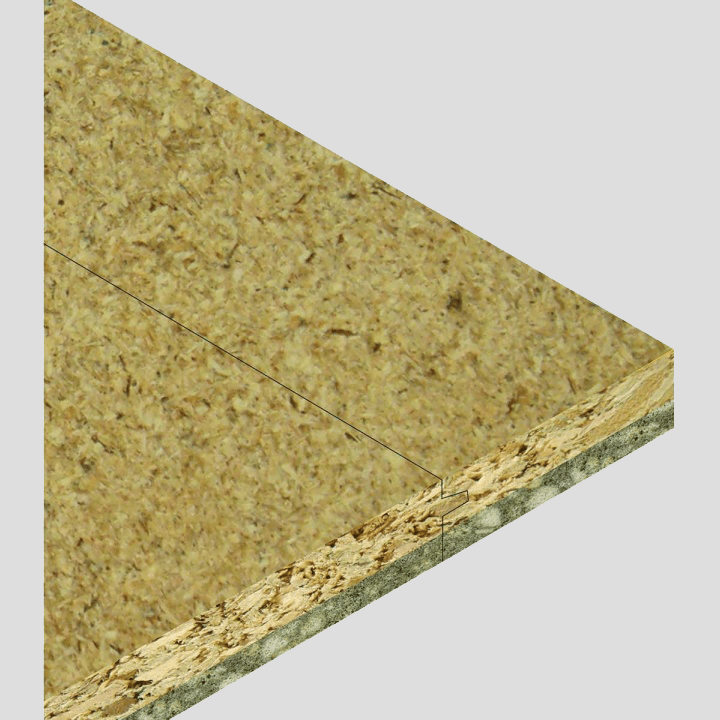Saving energy and reducing bills are likely to be high on the agenda for many of your customers, and installing some good-quality loft insulation is one of the best ways you can help them to achieve their energy-saving goals and improve thermal performance.
In this guide, we’ll take a look at some of the facts about loft and roof insulation and a couple of the myths that have been passed around building sites over the years. We’ll also discuss loft insulation dos and don’ts as well as the overall benefits of loft insulation that you can explain to your customer.
We’ll explore other types of insulation too, including floor, wall and roof insulation, and explain the differences between, and benefits of, each type.
Why Should You Insulate the Loft?
Before we get into the facts around loft insulation, it’s important to define why it’s important. According to the Energy Saving Trust, a quarter of heat is lost through the roof in an uninsulated home. This means that by simply insulating the roof and loft area, your customers can effectively reduce a significant amount of heat loss and therefore reduce their heating bills.
If your customer has a loft, they absolutely need loft insulation. As well as reducing energy bills and increasing the home’s overall value when your customer looks to sell, there are many other loft insulation benefits. Not only does it help to keep your home nice and warm in the winter months, but it can also contribute to the better health of the people in the home by reducing condensation and dampness, which can lead to the growth of mould and cause respiratory issues. It can also help the environment by reducing CO² emissions and can extend the lifespan of your boiler, too.
MYTH: You might have heard the myth that homes in warm climates don’t need insulation since they’ll be kept warm by the outdoor temperatures. However, while insulation helps to trap heat in the home and keep it warm, it also acts as a barrier to heat, ensuring heat from the air doesn’t warm up the building too much.
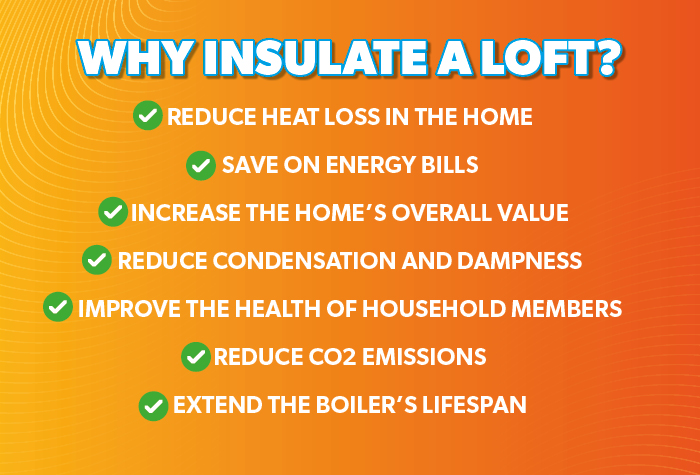
What’s the Difference Between Loft and Roof Insulation?
Loft insulation and roof insulation are often used by many interchangeably, but there is a difference.
Roof insulation is installed into the eves of the roof, while loft insulation goes on, and in between, the floor joists in the loft.
Cold or Warm Roof Insulation: What’s the Difference?
Cold Roof Insulation
When insulating a flat roof, you can choose between a warm roof or a cold roof. A cold roof has insulation laid between the rafters (the sloping timbers that make up the underside of the roof) and this is a very low-impact way to insulate a roof. This means that the ceiling below the roof is well insulated, but the roof structure itself is left uninsulated. On a cold day, the cold will conduct through the rafters and into the room below.
Warm Roof Insulation
A warm roof structure is designed to allow for insulation above the rafters but below the counter battens, creating more thermal efficiency and a warmer space - hence the term ‘warm roof’. Warm roof insulation can be used on both flat and pitched roofs, although it’s the more natural choice for pitched roofs. Warm flat roofs are not always achievable in refurbishments and are typically used in new builds since it’s difficult to insulate above roof rafters of an existing building.
Insulating between roof rafters is an efficient way to insulate a roof space and is recommended alongside both warm and cold roof insulation. By adding flat or pitched roof insulation between rafters and over or under them, you can create a warm and thermally efficient space that also improves fire and acoustic performance.
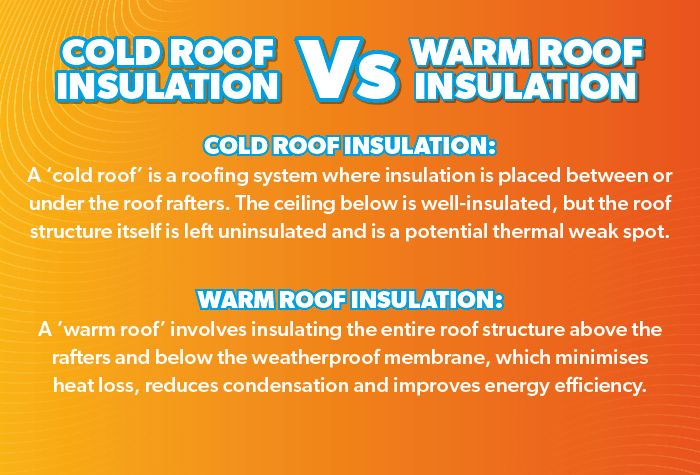
Cold Lofts vs Warm Lofts: What’s the Difference?
Cold vs warm roof insulation is not to be confused with a cold or warm loft space.
Whether you need a ‘cold loft’ or ‘warm loft’ depends on what your customer intends to use the loft space for. For loft conversions and hobby rooms, or storing materials that are sensitive to temperature, a warm loft is better for creating usable floor space. Otherwise, a cold loft will be fine.
Cold Lofts
A cold loft is much cheaper and easier to install than a warm loft. The only insulation used in a cold loft is in the floor of the loft, on top of and in between the floor joists. This loft floor insulation stops heat from getting into the loft area.
MYTH: Don’t be fooled by the name ‘cold loft’ and assume that they are always cold. This type of loft insulation is prone to temperature fluctuations, getting very cold in the winter but very hot in the summer.
Cold loft insulation can also be subject to condensation and dampness, so if you’re looking to store materials in there, or turn the loft into a usable room, you’ll probably need warm loft insulation instead.
Warm Lofts
To create a ‘warm loft,’ both the floor joists and the underside of the roof need to be insulated. With a warm loft, heat can get into the loft but cannot escape through the roof, resulting in better temperature regulation and energy efficiency.
How Much Loft Insulation Do I Need?
To calculate how much roof insulation you need between the rafters of a roofing job, you’ll first need to multiply the length and width of each rafter space to work out the total area you need to cover. Once you have the total area, you will know how much insulation you need overall, and you can figure out how many insulation boards you need based on the length per board. You can use the same method for working out how many rolls of loft insulation you need for the floor.
Next, it’s time to think about your loft insulation thickness. This will depend on the rafter depth and any areas of ventilation you need to allow for, while also considering building regulations for roof insulation thickness. In the UK, the loft insulation recommended depth / thickness is at least 270mm – 300mm thick to be optimally energy efficient.
What are the Regulations for Loft Insulation?
As you’ll already know, any building work needs to be carried out in accordance with Building Regulations - and roof and loft insulation are no different.
Roof and loft insulation requirements and regulations are concerned with the U-value - a measure of how much heat is lost through the thickness of a particular material. Part L in the Building Regulations, or Section 6 in Scotland, states that the U-value of a roof refurbishment insulated at rafter level should be 0.18 W/m2.K. If the insulation is for a new build in England and Wales, this should be 0.11 W/m2.K, or 0.15 W/m2.K if you’re in Scotland.
Building Regulations also recommend a minimum thickness of 270mm for loft insulation when using mineral wool, helping your clients to reach optimal energy efficiency.
Best Loft Insulation Between Rafters
When insulating a loft space, there are many choices to make when it comes to the materials. You’ll need to consider the roof construction, what the space will be used for and all the criteria of the project outlined by your customer. For example, will the area be used simply for storage or as a liveable hobby space? If it’s a usable space, does your customer require soundproofing too or any other extras?
MYTH: A common myth you might have come across is that roof insulation is a fire hazard. While there are some roof insulation materials that pose more of a fire risk, you will most often find that today’s insulation materials are non-combustible and can actually help to reduce the risk of fire. You can also take additional steps to further reduce the risk of fire hazards in the loft area.
Our Range of Insulation Materials
Here’s our pick of the best insulation materials that we stock at Selco. Order online for delivery or collection, or pop into your local branch to pick up what you need:
Cavity Wall Insulation
Whether your customer is planning on using their new loft space as storage or a living space, it needs to be protected from moisture and kept warm. Installing cavity wall insulation will ensure that heat is kept in, and damp is kept out.
Fire resistant, water repellent and vapour permeable, Rockwool Thermal Cavity Insulation is great for cavities in masonry walls. Easy to install, it will cover 3.28m² without sagging or slumping over time. The lightweight, easy-to-cut nature of Jabwall Cavity Insulation also makes it easy to install while also providing top-quality performance.
Floor Insulation
Floor insulation isn’t just important for keeping a space warm and dry, but for dampening any sound too. This makes installing floor insulation essential if a customer wants to use their loft as a living space, as it will help reduce the amount of noise travelling into the rooms below.
Jabfloor Insulation is a great all-round choice for loft spaces. Easy to handle, rot-proof and durable, you can be sure that this type of floor insulation will last and keep your client’s loft space protected.
Roof Insulation
Roof Insulation is key to keeping the roof free from damp and preventing heat from escaping. For large roof spaces, insulation boards are a good option. These rigid boards can be used to insulate both joists and rafters, making them an excellent choice whether you are insulating a warm or cold roof. Insulation boards are often more expensive than insulation rolls but can offer good thermal value at half the thickness if space is a dealbreaker for your customer.
Our IKO Enertherm PIR insulation boards have a seven-layer ALU lamination and can help to prevent thermal bridging and water ingress.
Acoustic Insulation
To stop footsteps or other noises from disturbing the rooms below, some form of acoustic insulation should be installed – especially if the loft is being used as a living space. While insulation rolls can offer a good level of soundproofing, if your customer is looking for better noise-reducing performance, you could opt for the addition of acoustic boarding. We stock the easy-to-install Deckfon Acoustic Chipboard which can be used as an overlay treatment for conversion and refurbishment projects.
Complete Loft Insulation
If you’re looking for an all-round solution, then there are many general loft insulation options available. Designed specifically for loft spaces, Rockwool Thermal Loft Roll is lightweight and easy to handle. This medium-density mineral wool insulation can also withstand temperatures up to 1000°C, helping to reduce the risk of fire spreading. Aside from its thermal properties, Rockwool is also an excellent choice for noise reduction with a high acoustic performance, helping to reduce unwanted noise.
Our selection of Knauf Insulation offers lightweight material for easy installation. The Knauf Loft Roll is a flexible, glass mineral wool insulation roll that’s ideal for thermal insulation of pitched roofs and loft insulations. We stock a selection of sizes to ensure you get the right amount for the job.
Get the Supplies you Need
FAQs
-
How long does loft insulation last?
Depending on the type of insulation material you’ve used, your loft insulation can last for up to 100 years! Fibreglass and mineral wool insulation are usually around the 30-year mark. So long as the insulation is installed properly, looked after well and its condition is checked regularly for damp, damage or infestations, your customer’s loft insulation will last for many decades.
-
What is loft insulation made of?
Loft insulation can be made from many different materials, including glass mineral wool, fibreglass, cellulose or foam, and it’s often sold as rolls, boards or loose-fill insulation.
-
Can you use loft insulation in walls?
Loft insulation is lightweight and designed for horizontal applications i.e. ceilings and shouldn’t be used as wall insulation. To insulate walls, you’ll need cavity wall insulation or insulation boards designed for wall-insulating applications.
-
What’s the best loft insulation?
It’s hard to say which loft insulation is best because all your projects will have different requirements and preferences laid out by your customer. Each type of loft insulation will have advantages and benefits surrounding thermal performance, fire resistance, affordability and moisture resistance. Make sure to thoroughly research your insulation options to decide the right product for the job.

By Rae Davis
Rae is a Digital Copywriter within the Selco Team with 10 years' experience in the construction industry and specialises in long-form content writing. With a love for research and simplifying complicated information into easy-to-follow content, she is known for her handy how-to blogs. When she’s not at her desk, she’s got her head either in a book or up in the clouds.
< Back to Roofing
